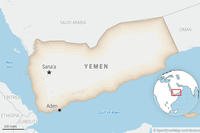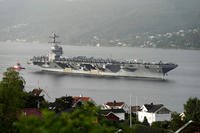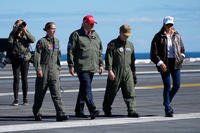The first Marine artillery unit on the ground in Iraq fighting Islamic State militants made its mark in the fight, the commander who sent in the Marines said this week.
The 26th Marine Expeditionary Unit deployed last October in what was supposed to be a seven-month deployment in waters around Europe and the Middle East. But nearly 200 Marines would end up on the front lines of the fight against ISIS.
The world learned the Marine artillery detachment had entered Iraq with news of tragedy: Staff Sgt. Louis Cardin, 27, was killed in a rocket attack at Fire Base Bell, a new outpost in Northern Iraq created shortly before the Marines occupied it.
Cardin was the second U.S. service member to be killed in the fight against ISIS, and the first Marine.
Shortly after Cardin's death, Marine Corps Commandant Gen. Robert Neller praised the Marine's leadership and commitment to duty.
"He was leading his Marines in combat," Neller said March 26 at a Marine Association event. "They were in indirect fire and he made sure everybody got in the bunker, and he just didn't make it in time … That's sad. But if you're going to go, you want to go in the fight."
The commander of the 26th MEU, Col. Robert Fulford, said that the artillery battery, which consisted of two M777A2 howitzers and two 120-mm mortar systems and was nicknamed Task Force Spartan, had fired more than 2,000 rounds at the enemy in 486 fire missions during their brief three months in Iraq.
"The whole team did a fantastic job," Fulford told an audience at the Potomac Institute near Washington, D.C., on Thursday.
Fulford said preparation for the possibility of deployment into Iraq had begun months ahead of time, as the MEU conducted training around the Middle East.
"There was a discussion of ways to accelerate the campaign in Iraq. You heard the secretary of defense refer to that, I believe as early as the December timeframe," Fulford said. "We began to get indications that some of those accelerants may reside inside of the 26th MEU inventory. And so we started preparing for it."
While Marines attached to Special Purpose Marine Air-Ground Task Force Crisis Response-Central Command were already on the ground in two locations in Iraq, the task force did not have any artillery assets. Fire Base Bell, formally known as the Karasoar Counterfire Complex, was established near Makhmour to support Iraqi troops who were putting pressure on the ISIS stronghold of Mosul.
Ahead of a deployment order, the MEU offloaded about 80 artillerymen, 80 riflemen, and 20 engineers and other enablers in Kuwait in February. They would spend a month together training, resting and firing weapons ahead of their insertion into Iraq.
Meanwhile, the MEU sent a team in to scout the location of the base, working with the Army and local personnel to build an austere position that would support the Marines.
Before the battery deployed to Iraq, Fulford and the MEU's senior enlisted leader, Sgt. Maj. Brett Scheuer, paid a personal visit to the unit in Kuwait to encourage them and prepare them for a mission with high stakes that would become apparent all too soon. Fulford said he sent them off with a pep talk. The battery would outstay the MEU by a month in the Middle East, returning home in June after handing control of their position off to the Army.
"Hopefully you are proud of them, because I am," Fulford said. "They did a magnificent job."









